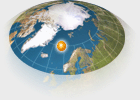
|
As the previous two chapters have
shown, the complicated situation with the reindeer husbandry in
the Kola Peninsula results from several interconnected issues
involving different types of social and economic actors.
1.
There is an urgent need of investments in order to (re)create
the market for reindeer products: meat, antlers, skins.
Because of the specific political and legislative climate in
Russia nowadays, western investors are confronted to a
“non-favourable” environment: rather reluctant to foreign
investors (World Bank Report, 1996), Russian legislation has
emphasised the “insider privatisation” by the
“Workers’-and-managers’ collectives”. By helping the
continuity of social relations and maintaining collective economic
actors this privatisation scheme avoids painful social imbalance
in remote communities. Therefore, for such a collective economic
activity as the reindeer husbandry, it might appear as a
“good” strategy for many social points of view, except for the
most important one: the market. Indeed, the reindeer husbandry is
condemned without markets for its production. Today, there is no
internal market for reindeer products. Reindeer meat is
practically absent from the formal market in the Kola peninsula
out of the tundra. After surviving exclusively on reindeer meat in
the tundra camps, I have never seen reindeer meat sold in Revda,
Kirovsk, Apatity, or Murmansk. Lovozero is maybe the only
settlement connected to the communication system where reindeer
meat could be found, because of the sovkhoz “Tundra”
and the Swedish slaughter-house there. The reasons for this
situation are economic (people have no cash for the expensive
reindeer meat) and cultural (the great majority of the population
on the Kola peninsula are labour migrants from the south, so they
have not habitudes to eat reindeer). The situation with other
reindeer products (antlers, skins) seems to be even worse.
On the other hand, potential western investors are
confronted by the recently increasing “anti-western” public
discourse, especially after NATO’s attack on Yugoslavia.
Despite all these problems, the Norfrys-Polarica
case shows that foreign investments are possible and could
work in this complicated system.
As for relying on local resources for recreating a market,
this implies a kind of local initiative and entrepreneurship of
which I have not seen (m)any signs so far. Therefore it would not
be realistic to rely on a private initiative in the short term,
but rather on more autonomic self-managed collectives based on a
kinship-like structure and using the infrastructure of the former
sovkhoz. I think this is a tendency bound to increase when
favourable socio-economic circumstances will eventually appear.
However, that higher level of autonomy could not be expected
before the resolution of the following two points:
2.
Regulation of the indigenous rights of the tundra-located
people.
In my view, there is an urgent need
of more appropriate regulation of the rights on the traditional
reindeer-herding territory, actually threatened and maltreated by
some powerful industrial enterprises, military and other smaller
poachers. Even if there is a (blurred) legislation on this matter,
it doesn’t actually work because of the informal character of
the economic relationships based exclusively on barter deals.
Corruption in the centres of power complicates the situation.
According to the rumours in the tundra, “the inspectors of
hunting and fishing are the greatest poachers”. Hunting permits
are readily obtained especially for those occupying key-position
in administrative centres. As for the industrial actors, they
usually apply strong lobbying on the political powers at regional
or central level. In these cases, the powerless herding
collectives are not able to maintain the fight for tundra
resources and are threatened with the loss of traditional
territories for reindeer herding.
Based on the above, I believe that these small and remote
communities need extensive external assistance to give them both
an effective infrastructure and more political power. Only then
could one expect to see them become real economic actors. In that
sense, the aboriginal property-rights experience from Scandinavian
and North American Arctic could be useful for the economic
development of the reindeer husbandry in the region.
3.
Finally, the economic stabilisation of the urban centres is
of a great importance for the solution of the problems in the
tundra. As I mentioned in the second chapter, the massive loss of
jobs after 1991 in the military complex and in the mining industry
is the major cause of the poaching problem. It involved new actors
in the tundra, some of them able to threaten whole herd(s)
(according to the herders). For many of these actors poaching is a
survival strategy. Therefore it is not expected they could change
strategies in the present socio-economic context. Far from
favouring the emergency of a market, this process only redefines
the informal social relationships based on barter deals. The
paradox is that the only imaginable economic growth in the Kola
peninsula by now is related to the mining industry. So the
question is: Would an adequate industrial revival in the region be
able to help the reindeer herders in the tundra?
|
